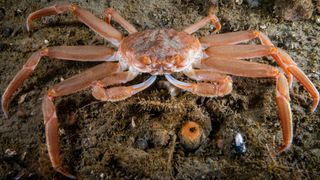What made billions of snow crabs disappear from the Bering Sea?
The Bering Sea's snow crab population has been in decline over the last five years, but this season the population has collapsed.

Snow crabs in the Bering Sea once numbered in the billions. But after a recent and massive population crash the crabs have all but vanished from these waters — and they may not be coming back anytime soon.
In 2018, about 3 billion mature snow crabs (Chionoecetes opilio) inhabited the Bering Sea along with roughly five billion immature crabs, the Seattle Times reported. But by late 2021, those numbers hovered around 2.5 million and 6.5 million, respectively — a loss of nearly eight billion crabs in just three years. In February, the National Marine Fishing Service issued an official overfishing notice for the population, and in early October, officials at the Alaska Department of Fish and Game (ADFG) made the difficult decision to cancel the season's snow crab harvest for fear of wiping out the crustaceans altogether.
“Management of Bering Sea snow crab must now focus on conservation and rebuilding given the condition of the stock,” ADFG representatives said in a statement. The agency also canceled the fall harvest of Bristol Bay red king crabs (Paralithodes camtschaticus), due to low survey numbers.
Miranda Westphal, an area management biologist with the Alaska Department of Fish and Game, called the decision "tremendously difficult."
"It came after a lot of sleepless nights and a lot of tears. It was one of the hardest decisions we've ever had to make," she told Live Science
What caused the snow crab crash? The main culprit was almost certainly human-caused climate change, though unsustainable fishing practices may also have played a role, the Seattle Times reported.
Snow crabs thrive in the cold northern waters of the Bering Sea floor. For these crabs, water temperature isn’t just a matter of comfort; it plays a critical role in their lifecycle. As seawater cools, it becomes less salty and less buoyant, causing it to sink to the bottom of the ocean. Marine biologists refer to this chilly layer of water as the "cold pool, according to the National Oceanic and Atmospheric Administration (NOAA). Many fish and other types of marine life avoid the cold pool, but for juvenile snow crabs, it’s a sanctuary. With virtually no predators willing to venture into this layer's frigid waters, young crabs can grow up in peace.
Sign up for the Live Science daily newsletter now
Get the world’s most fascinating discoveries delivered straight to your inbox.
But lately that protection has waned. Record heat waves in 2016, 2018 and 2019 stunted cold pool formation in the Bering Sea, leaving baby crabs vulnerable to predators, according to a Sept. 2 report published by NOAA. What's more, Westphal said, the warmer waters likely sped up the adult crabs' metabolism, causing them to starve. As anthropogenic climate change progresses over the next few decades, these types of heatwaves are projected to become more common, according to the report.
In addition to climate change, some commercial fishing practices may have contributed to the sharp decline in crab numbers. Trawling vessels targeting other marine species in the Bering Sea frequently encounter, catch and discard unwanted snow crabs as "bycatch" ” And when snow crab fishers haul a catch aboard, they toss out crabs that are deemed too small, too young, or whose shells are discolored or marred in some way.
Sometimes the crabs survive the shock of being suddenly transported to the surface and then thrown back into the water — but often they do not. In 2020, the ADFG estimated that over 30% of all snow crabs that were captured and tossed back into the Bering Sea died as a result, the Seattle Times reported in April. NOAA’s 2021 assessment for Bering Sea snow crabs corroborated these grim findings, with snow crab mortality rising that year and populations plummeting.
Crabbing is big business in Alaska. The cancellation of crab season this year and the uncertain future of the Bering Sea's snow crabs could have dramatic implications for the industry, which garnered some $280 million in 2016, Anchorage Daily News reported, and for many local fishers who depend on snow crabs for their livelihoods.
"People are simply going to go bankrupt and they’re not going to be able to feed their families," Jamie Goen, executive director for Alaska Bering Sea Crabbers, told KIMA-TV, a television station in Yakima, Washington.
Goen's group, along with several others, is currently calling on the North Pacific Fishery Management Council to impose better conservation measures to help rebuild a sustainable snow crab population, KIMA-TV reported.
But for now, the crabs will remain off-limits for commercial fishers. "We want to give them the best chance to recover," said Westphal.

Joanna Thompson is a science journalist and runner based in New York. She holds a B.S. in Zoology and a B.A. in Creative Writing from North Carolina State University, as well as a Master's in Science Journalism from NYU's Science, Health and Environmental Reporting Program. Find more of her work in Scientific American, The Daily Beast, Atlas Obscura or Audubon Magazine.
